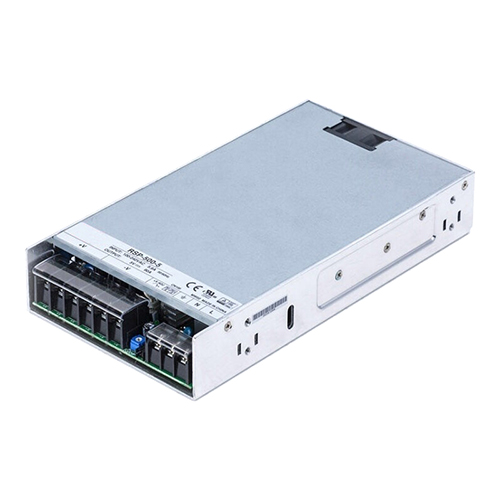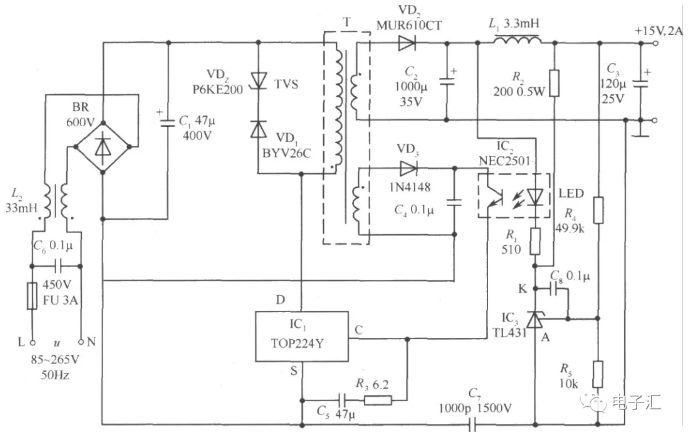
What is a switching power supply?
With the development and innovation of power electronics technology, switching power supply technology is also constantly innovating. At present, switching power supplies are widely used in almost all electronic devices due to their small size, light weight, and high efficiency, and are an indispensable power supply method for the rapid development of the electronic information industry today.
A switching power supply is a type of power supply that utilizes modern power electronics technology to control the time ratio of switching on and off, and maintain a stable output voltage. Switching power supplies are generally composed of pulse width modulation (PWM) control ICs and MOSFETs.
Switching power supplies are relatively linear power supplies, in which the input directly rectifies AC power into DC power, and under the action of high-frequency oscillation circuits, switches are used to control the on/off of current, forming high-frequency pulse currents. With the help of an inductor (high-frequency transformer), stable low-voltage direct current is output.
Due to the inverse ratio between the size of the magnetic core of the transformer and the square of the operating frequency of the switching power supply, the higher the frequency, the smaller the iron core. This can greatly reduce the transformer, reducing the weight and volume of the power supply. And because it directly controls DC, the efficiency of this power supply is much higher than that of linear power supply. This saves energy, so it is favored by people. But it also has drawbacks, such as complex circuits, difficult maintenance, and serious pollution to the circuits; The power supply has high noise and is not suitable for certain low noise circuits.
Characteristics of Switching Power Supply
Switching power supplies are generally composed of pulse width modulation (PWM) control ICs and MOSFETs. With the development and innovation of power electronics technology, switching power supplies are widely used in almost all electronic devices due to their small size, light weight, and high efficiency, and their importance is evident.
Classification of Switching Power Supplies
According to the way switching devices are connected in the circuit, switching power supplies can generally be divided into three categories: series switching power supplies, parallel switching power supplies, and transformer switching power supplies.
Among them, transformer type switching power supplies can be further divided into various types, such as push-pull, half bridge, full bridge, etc. According to the excitation of the transformer and the phase of the output voltage, it can be further divided into various types: forward excitation, flyback, single excitation, and double excitation.
The difference between switching power supply and regular power supply
A regular power supply is usually a linear power supply, which refers to a power supply that operates in a linear state with an adjustment tube. But in switching power supplies, it is different. The switch transistor (in switching power supplies, we generally refer to the adjustment transistor as the switch transistor) works in two states: on - the resistance is very low, and off - the resistance is very high.
Switching power supply is a relatively new type of power supply. It has the advantages of high efficiency, light weight, adjustable voltage, and high output power. However, due to the circuit working in the on/off state, the noise is relatively high.
Example: Step-down switching power supply
Let's briefly talk about the working principle of a step-down switching power supply: the circuit is composed of a switch (in actual circuits, it is a transistor or field-effect transistor), a freewheeling diode, an energy storage inductor, a filtering capacitor, etc.
When the switch is closed, the power supply supplies power to the load through the switch and inductor, and stores some of the electrical energy in the inductor and capacitor. Due to the self inductance of the inductor, the current increases slowly after the switch is turned on, meaning that the output cannot immediately reach the power supply voltage value.
After a certain period of time, the switch will disconnect, and due to the self inductance effect of the inductor (which can be more vividly considered as the inertia effect of the current in the inductor), the current in the circuit will remain unchanged, that is, continue to flow from left to right. This current flows through the load, returns from the ground wire, flows to the positive pole of the freewheeling diode, passes through the diode, and returns to the left end of the inductor, forming a circuit.
By controlling the time it takes for the switch to close and open (i.e. PWM pulse width modulation), the output voltage can be controlled. If the on/off time is controlled by detecting the output voltage to maintain the output voltage unchanged, the purpose of voltage stabilization is achieved.
Both regular power supplies and switch power supplies have voltage regulators that use feedback principles for voltage stabilization. The difference is that switch power supplies use transistors for adjustment, while regular power supplies generally use the linear amplification region of the transistor for adjustment. Comparatively speaking, switching power supplies have low energy consumption, a wider range of applications for AC voltage, good ripple coefficient of output DC, but the disadvantage is switch pulse interference.
The main working principle of a regular half bridge switching power supply is that the switching tubes of the upper and lower bridges (VMOS when the frequency is high) take turns conducting. First, the current flows into the upper bridge switching tubes, and using the storage function of the inductor coil, the electrical energy is concentrated in the coil. Finally, the upper bridge switching tubes are turned off, and the lower bridge switching tubes are turned on. The inductor coil and capacitor continue to provide external power. Then turn off the lower bridge switch and open the upper bridge to allow current to enter. Repeat this process because you need to turn on and off the two switch tubes in turn, so it is called a switching power supply.
However, linear power supplies are different. Due to the lack of switch intervention, the water supply pipe keeps discharging water. If there is too much, it will leak out. This is what we often see in some linear power supplies. The adjustment pipe generates a lot of heat, and all the unused electricity is converted into heat energy. From this perspective, the conversion efficiency of linear power sources is very low, and when the heat is high, the lifespan of the components is bound to decrease, which affects the final use effect.
Main difference: Working mode
The power regulator of a linear power supply always operates in the amplification region, and the current flowing through it is continuous. Due to the high power loss on the adjustment tube, a larger power adjustment tube is required and equipped with a large heat sink, which generates severe heat and has low efficiency, generally ranging from 40% to 60% (or even a good linear power supply).
The working mode of linear power supply requires a step-down device to change from high voltage to low voltage. Generally, it is a transformer, but there are also other types of KX power supply that output DC voltage through rectification. In this way, the volume is also large, relatively bulky, inefficient, and generates a large amount of heat; But there are also advantages: small ripple, good adjustment rate, low external interference, suitable for use in analog circuits/various amplifiers, etc.
The power device of a switching power supply works in the on/off state, and energy is stored temporarily through the inductor coil during voltage adjustment. This reduces its loss, improves efficiency, and requires low heat dissipation. However, it also has higher requirements for transformers and energy storage inductors, requiring materials with low loss and high magnetic permeability. Its transformer is just one word small. The total efficiency is between 80% and 98%. Switching mode power supplies have high efficiency but small size, but compared to linear power supplies, their ripple and voltage and current adjustment rates have a certain discount.